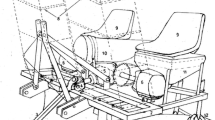Abstract
Present research was conducted to modify and evaluate commercially available tractor-operated sugarcane trench planter available in Uttar Pradesh as per needs of local conditions prevailing in Punjab for sugarcane cultivation. Prominent modifications included alteration in shape of soil-covering unit and installation of safety grate. During preliminary evaluation, effect of three cutting roller(s) peripheral speeds (0.69 m/s, 0.81 m/s and 0.93 m/s) and three forward speeds (2.26 km/h, 2.6 km/h and 3.0 km/h) was assessed on three popular varieties of sugarcane (Co0118, CoPb93 and CoJ-85) for cane length, cane diameter, sett length, bud damage (%), number of sett cut and sett damage (%). Thereafter, the field evaluation of modified sugarcane trench planter was carried out by selecting one cutting roller(s) peripheral speed (0.69 m/s) and two forward speeds (2.26 km/h and 3.0 km/h) on above varieties. The selected dependent variables were cane length, cane diameter, sett length, bud damage (%), sett damage (%), overlap/gap and germination (%). Results revealed that average sett length increased with the decrease in diameter of cane and cutting roller peripheral speed. However, bud damage (%) increased with the increase in cutting roller peripheral speed. Bud damage (%) in variety Co0118 was higher due to relatively more toughness (hardness) of cane. Average overlapping decreased with the increase in forward speed. Practically, no sett damage was observed in the study. It was found that germination (%) of cane planted by machine was more than the conventional planting. Average germination on 45 DAP (days after planting) on left and right side of trench in different varieties, viz. Co0118, CoPb93 and CoJ-85, were 50.71%, 43.00%, 48.50% and 48.11%, 38.68%, 43.15%, respectively. Economic analysis showed that there was 25.01% reduction in cost of planting and 58.02% reduction in labour cost as compared to conventional method of sugarcane planting followed under Punjab conditions.




Similar content being viewed by others
References
Bhullar, M.S., K.S. Thind, S.K. Uppal, and K. Singh. 2008. Productivity, profitability and quality of sugarcane (Saccharumsp) plant-ratoon system in relation to planting methods and seeding rate. Indian Journal of Agronomy 53: 195–199.
Anonymous. 2018. Directorate of sugarcane development website. https://sugarcane.dac.gov.in/StatisticsAPY.pdf. Accessed 10 June 2018.
Devi, C., K.L. Rao, and D.V.M. Raju. 1990. Studies on the effect of row space and nitrogen on yield and quality of early maturing sugarcane varieties. Indian Sugar 40: 541–544.
Kumar, M., and A. Tripathi. 2015. To study of the different modes of tillage for the performance of sugarcane cutter planter. International Research Journal of Engineering and Technology 2: 1416–1425.
Kumar, R., M.C. Roe, and O.U. Scremin. 1995. Methods for estimating the proper length of a cane. Archives of Physical Medicine and Rehabilitation 76: 1173–1175.
Malik, K.B., F.G. Ali, and A. Khaliq. 1996. Effect of plant population and row spacing on cane yield of spring-planted cane. Journal of Agricultural Research 34: 389–395.
Mandal, S.K., and P.K. Maji. 2008. Design refinement of 2 row tractor mounted sugarcane cutter planter. Agricultural Engineering International 10: 6–20.
Patil, A., A.K. Dave, and R.N.S. Yadav. 2004. Evaluation of sugarcane cutter planter. Sugar Tech 6: 121–125.
Sharma, M.P., S.R. Misra, and A. Mishra. 2006. Recent development in sugarcane mechanization in India. Agricultural Mechanization in Asia, Africa and Latin America 37: 33–35.
Singh, A.K., S.N. Singh, A.K. Rao, and A. Kumar. 2013. Productivity, uptake of nutrients and soil fertility status under modified trench method of sugarcane planting. Sugar Tech 15: 219–222.
Singh, J., A.K. Singh, M.P. Sharma, P.R. Singh, and A.C. Srivastava. 2011. Mechanization of sugarcane cultivation in India. Sugar Tech 13: 310–314.
Singh, R.D., A.C. Srivastava, and H.N. Shahi. 2009. Performance evaluation of seeder-cum- sugarcane cutter planter. Agricultural Engineering Today 33: 3–6.
Yadav, R.N.S., M.P. Sharma, S.D. Kamthe, A. Tajuddin, S. Yadav, and R.K. Tejra. 2002. Performance evaluation of sugarcane chopper harvester. Sugar Tech 4: 117–122.
Acknowledgements
Authors are thankful to PAU, Ludhiana, and ICAR for providing resources to conduct the study.
Funding
Authors acknowledge funding by PAU, Ludhiana, and ICAR for the study.
Author information
Authors and Affiliations
Corresponding author
Ethics declarations
Conflict of interest
The authors declare that they have no conflict of interest.
Rights and permissions
About this article
Cite this article
Kumar, M., Dogra, B., Sanghera, G.S. et al. Modification and Evaluation of Commercially Available Sugarcane Trench Planter for Its Application Under Punjab Conditions. Sugar Tech 21, 586–595 (2019). https://doi.org/10.1007/s12355-018-0679-y
Received:
Accepted:
Published:
Issue Date:
DOI: https://doi.org/10.1007/s12355-018-0679-y



